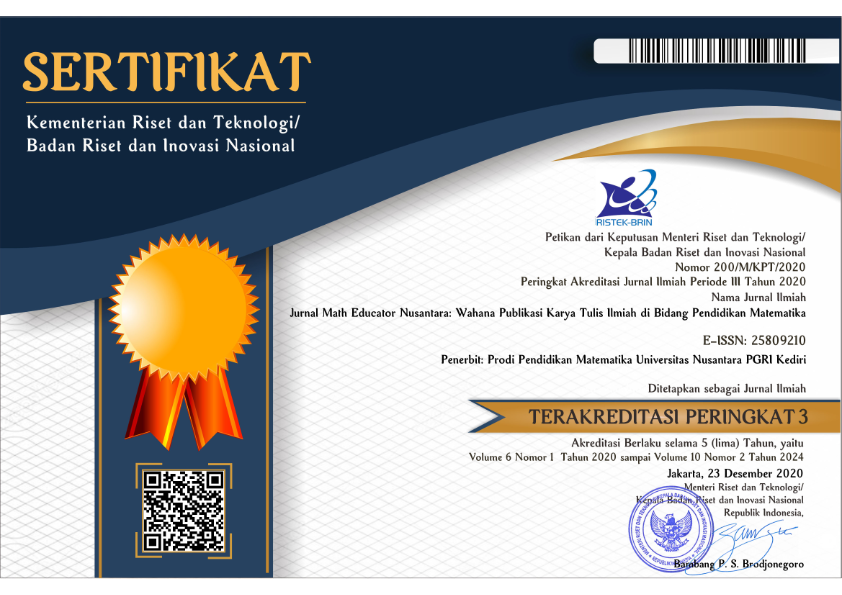Ethnomathematics: A mathematical exploration on the layout of tui gubuk and the architecture of Segenter Traditional House
DOI:
https://doi.org/10.29407/jmen.v7i2.16519Keywords:
Mathematical ideas, Tui gubuk layout, Traditional house, House architectureAbstract
Mathematics is found in many activities of traditional culture. However, many perceive that mathematics is culture-free. Based on the occurring phenomenon, ethnomathematics study is made as the connector between mathematics and culture. The presence of ethnomathematics provides many opportunities to discover unique mathematical ideas exist in the traditional culture. This research aims to explore mathematical ideas in the layout of tui gubuk and the architecture of Segenter traditional house that can be made as mathematics learning sources. This study was a qualitative research with ethnographic method. This study was conducted in the traditional village of Segenter, Sukadana Village, Bayan District. Data were collected through an observation and interviews with Adat figures, cultural anthropologists, and traditional leaders who have the knowledge of the customs and culture of Bayan people, which consisted of three informants. Research results indicate that there are mathematical ideas in the layout of tui gubuk and the architecture of Segenter traditional house that can be made as the learning sources of mathematics and can be developed in mathematics learning, especially in materials of set and geometry, both geometry of space and flat geometry.
References
Ascher, M., & D’Ambrosio, U. (2012). Ethnomathematics : a Dialogue. For the Learning of Mathematics, 14(2), 36–43.
Bada, & Olusegun, S. (2015). Constructivism: A Paradigm for Teaching and Learning. Journal of Research & Method in Education, 5(6), 66–70. https://doi.org/10.4172/2151-6200.1000200
Banks, J. (1991). A curriculum for empowerment, action, and change. In C. Sleeter (Ed.), Empowerment through multicultiral education (pp. 125–142). Albany, NY: SUNY Press.
Berry, K. (2011). The ethnographic choice: Why ethnographers do ethnography. Cultural Studies - Critical Methodologies, 11(2), 165–177. https://doi.org/10.1177/1532708611401335
Bishop, A. (2014). The relationship between mathematics education and culture. Iranian Mathematics Education Conference in Kermanshah, Iran, December.
Bishop, A. J. (1988a). Mathematics Education and Culture. London, Kluwer Academic Publisher. https://doi.org/10.1007/BF00751233
Bishop, A. J. (1988b). Mathematics education in its cultural context. Educational Studies in Mathematics, 19(2), 179–191. https://doi.org/10.1007/BF00751231
D’Ambrosio, U. (1985a). Ethnomathematics and its Place in the History and Pedagogy of Mathematics. For the Learning of Mathematics, 5(1), 44–48.
D’Ambrosio, U. (1985b). Ethnomathematics and its place in the history and pedagogy of mathematics. For the Learning of Mathematics, 5(1), 44–48. https://doi.org/10.1515/9783110245585.230
D’Ambrosio, U., & D’Ambrusio, B. S. (2013). The Role of Ethnomathematics in Curricular Leadership in Mathematics Education. Journal of Mathematics Education at Teachers College, 4, 19–25.
D’Ambrosio, U., & Rosa, M. (2017). Ethnomathematics and Its Pedagogical Action in Mathematics Education. 285–305. https://doi.org/10.1007/978-3-319-59220-6_12
d’Entremont, Y. (2015). Linking Mathematics, Culture and Community. Procedia - Social and Behavioral Sciences, 174(1999), 2818–2824. https://doi.org/10.1016/j.sbspro.2015.01.973
Denzin, N. K., & Lincoln, Y. S. (2011). Routledge international handbook of qualitative nursing research. Sage Publications: USA. https://doi.org/10.4324/9780203409527
Fatrurrahman, L. A. (2016). Membaca arsitektur sasak. Genius, Mataram.
Gilmer, G. (1995). A definition of Ethnomathematics. ISGE Newsletter, International Study Group on Ethnomathematics, 11(1).
Khalimah, N., Farin, K. I., Nikmah, M., Ni’mah, K., & Jatmiko, J. (2017). Budaya Kediri Dalam Pembelajaran Matematika (Pengembangan Lembar Kegiatan Siswa (Lks) Berbasis Etnomatematika Melalui Pendekatan Saintifik). JIPMat, 2(1), 65–71. https://doi.org/10.26877/jipmat.v2i1.1482
Kline, M. (1990). Mathematics in Western Culture. Penguin.
Knijnik, G. (2002). Curriculum, Culture and Ethnomathematics: The practices of “cubagem of wood” in the Brazilian Landless Movement. Journal of Intercultural Studies, 23(2), 149–165. https://doi.org/10.1080/07256860220151050
Lee, O. (2003). Equity for Linguistically and Culturally Diverse Students in Science Education: A Research Agenda. Teachers College Record, 105(3), 465–489. http://www.elsevier.com/locate/scp
Orey, D. C. (2000). Mathematics across culture: the History of non-Western mathematics. In H. Selin (Ed.), The ethnomathematics of the Sioux tipi and cone (pp. 239–252). Dordrecht, Netherlands: Kulwer Academic Publishers.
Powell, A. B., & Frankenstein, M. (1997). Ethnomathematics: Challenging eurocentrism in mathematics education. New York Press. https://doi.org/10.16309/j.cnki.issn.1007-1776.2003.03.004
Reeves, S., Kuper, A., Hodges, B. D., Reeves, S., Kuper, A., & Hodges, B. D. (2008). Qualitative research methodology Ethnography. British Medical Journal, 337(7668), 512–514. https://doi.org/10.1136/bmj.alO20
Rosa, M., & Orey, D. C. (2013). Ethnomodeling as a Research Theoretical Framework on Ethnomathematics and Mathematical Modeling. Journal of Urban Mathematics Education, 6(2), 62–80. http://education.gsu.edu/JUME
Rosa, M., & Orey, D. C. (2015). A trivium curriculum for mathematics based on literacy, matheracy, and technoracy: an ethnomathematics perspective. ZDM - International Journal on Mathematics Education, 47(4), 587–598. https://doi.org/10.1007/s11858-015-0688-1
Skemp, R. (1987). The psychology of learning mathmatics. Hillsdale, New Jersey : Lawrence Erlbaum Associates.
Spradley, J. P. (2016). The Ethnographic Interview. In The SAGE Encyclopedia of Communication Research Methods. Reissued Long Grove, IL: Waveland Press, Inc. https://doi.org/10.4135/9781483381411.n168
Weldeana, H. N. (2016). Ethnomathematics in Ethiopia: Futile or Fertile for Mathematics Education? Momona Ethiopian Journal of Science, 8(2), 146. https://doi.org/10.4314/mejs.v8i2.4
Zaslavsky, C. (1991). Multicultural Mathematics Education For The Middle Grades. Arithmetic Teacher, 38, 18–21.
Zeichner, K. M. (1996). Educating teachers to close the achievement gap: Issues of pedagogy, knowledge, and teacher preparation. In B. Williams (Ed.), Closing the achievement gap: A vision for changing beliefs and practices (Issue May, pp. 56–76). Alexandria, VA: Association for Supervision and Curriculum Development.
Zulkardi. (2002). Developing a learning environment on mathematics education for Indonesian student teachers. Universiteit Twente.
Downloads
Published
Issue
Section
License
Authors who publish with this journal agree to the following terms:
- Copyright on any article is retained by the author(s).
- The author grants the journal, the right of first publication with the work simultaneously licensed under a Creative Commons Attribution License that allows others to share the work with an acknowledgment of the work’s authorship and initial publication in this journal.
- Authors are able to enter into separate, additional contractual arrangements for the non-exclusive distribution of the journal’s published version of the work (e.g., post it to an institutional repository or publish it in a book), with an acknowledgment of its initial publication in this journal.
- Authors are permitted and encouraged to post their work online (e.g., in institutional repositories or on their website) prior to and during the submission process, as it can lead to productive exchanges, as well as earlier and greater citation of published work.
- The article and any associated published material is distributed under the Creative Commons Attribution-ShareAlike 4.0 International License














